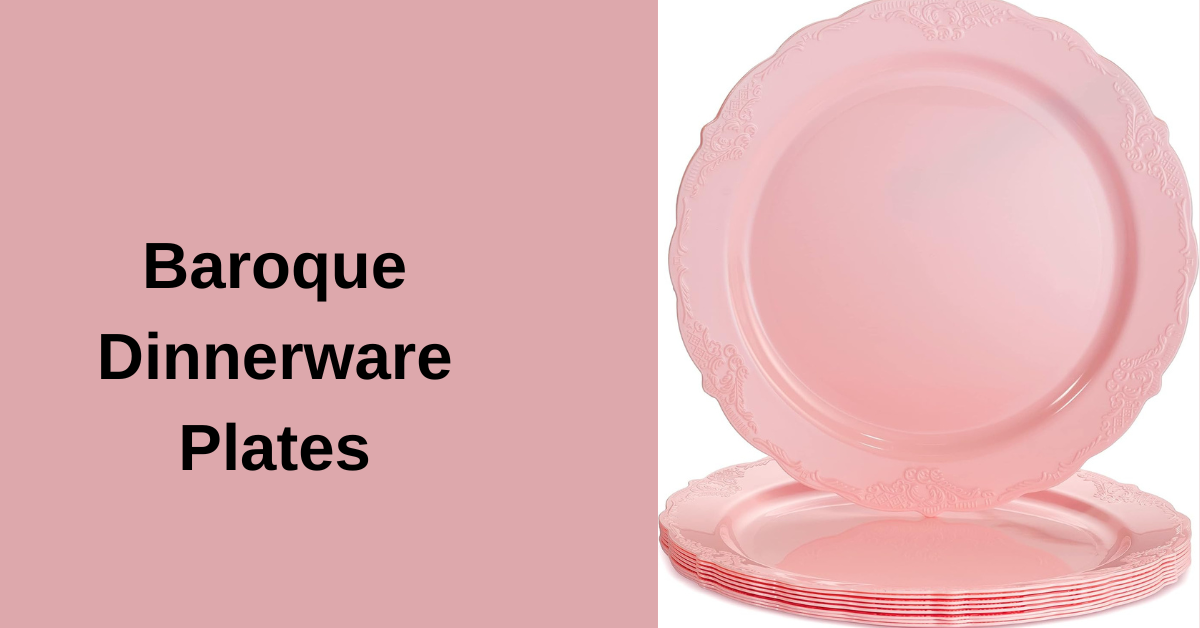Baroque dinnerware plates are exquisite pieces that add a touch of elegance to any dining experience. These plates demand particular care while washing due to their elaborate designs and fine craftsmanship. In this guide, we’ll walk you through the step-by-step process of washing and maintaining your precious Baroque dinnerware plates to ensure longevity and beauty.
Introduction to Baroque Dinnerware Plates
Baroque dinnerware plates are characterized by their ornate designs, rich colors, and intricate details. They often feature elaborate patterns, gilded edges, and decorative motifs that reflect the opulence of the Baroque art movement. Due to their artistic and historical significance, these plates deserve special attention for cleaning and preservation.
Understanding Baroque Dinnerware Materials
Knowing the materials your Baroque dinnerware plates are composed of is crucial before you start cleaning them. Common materials include porcelain, ceramic, and bone china. Each material has specific cleaning requirements to ensure the plates remain unharmed during the cleaning process.
Preparing for Washing
Gather all the necessary supplies before you start washing your Baroque dinnerware plates. You’ll need a mild, gentle detergent, a soft cloth, lukewarm water, and a soft brush. Set up a clean and organized workspace where you can safely handle the plates without risking dropping or damaging them.
Handling Fragile Baroque Plates
Baroque plates can be delicate, so handling them with care is essential. Use both hands to lift or move these plates, supporting the bottom to distribute the weight evenly. This reduces the risk of stress on fragile areas and minimizes the chance of accidental drops.
Initial Rinse
Before you start cleaning, gently rinse the plates to remove any loose food particles or debris. Hold the plates under lukewarm running water and use a soft brush to remove stubborn particles from crevices and patterns.
Hand Washing Technique
Hand washing is the preferred method for cleaning Baroque dinnerware plates. An appropriate amount of mild detergent and lukewarm water should be put in a sink. Gently place one plate at a time into the water and use a soft cloth to clean its surface. Use soft materials to avoid scratching the delicate pattern.
Dealing with Stains
Stains can be a concern when it comes to Baroque dinnerware plates. Use the proper stain removal techniques that will protect the design and glaze after determining the type of stain. For example, use a baking soda paste for stubborn stains, applying it gently and wiping it off with a soft cloth.
Cleaning Intricate Designs
Intricate patterns and crevices require special attention. To clean difficult-to-reach spots without causing damage, use delicate brushes, cotton swabs, or even toothpicks. To ensure thorough cleaning, take your time and proceed with caution.
Avoiding Harsh Chemicals
Baroque dinnerware plates’ delicate patterns and finishes can suffer irreparable damage from harsh chemicals. Do not use bleach, abrasive cleansers, or other potent chemicals that could damage the plates.
Dishwasher Consideration
While hand washing is recommended, some Baroque dinnerware plates may be labeled dishwasher-safe. However, it’s still wise to exercise caution. Place the dishes on the top rack of the dishwasher and select the gentle cycle with moderate detergent.
Drying Techniques
After washing, allow the plates to air dry on a clean and soft surface. Alternately, pat them dry with a gentle, lint-free cloth. This helps prevent water spots and streaks from forming on the surface.
Storing Baroque Dinnerware
Proper storage is crucial to prevent chipping and scratching. Consider using plate stands or felt separators to keep the plates safely separated. Keep them away from strong sunshine and severe temperatures in a dry, cold location.
Regular Maintenance
Establish a routine for cleaning and maintaining your Baroque dinnerware plates. Gentle daily care, such as wiping off dust and light debris, can go a long way in preserving their beauty over time.
Dealing with Chips and Cracks
If you notice minor chips or cracks, handle the plates carefully to prevent further damage. Consider consulting a professional restoration expert specializing in restoring antique and delicate dinnerware for more significant issues.
Displaying Baroque Plates
Baroque plates can also serve as stunning decorative pieces. When displaying them, choose safe and suitable options that protect the plates from accidental damage.
Summary of Care Tips
Caring for Baroque dinnerware plates involves gentle handling, careful cleaning, and proper storage. You can continue to savor their elegance and beauty for years by adhering to these guidelines and instructions.
Frequently Asked Questions
Can Baroque plates be used in the microwave?
It’s best to avoid using Baroque plates in the microwave, as the delicate designs and metallic accents could be damaged by the heat.
How do I remove stubborn stains?
For stubborn stains, create a paste using baking soda and water. Apply it gently to the stained area, then wipe it off with a soft cloth.
Is it safe to stack Baroque plates?
While stacking plates is generally not recommended to prevent scratching, if you must stack them, place a soft cloth or felt separator between each plate to protect their surfaces.
Conclusion
Baroque dinnerware plates are not just functional items; they’re pieces of art that deserve special care. Following the proper cleaning and maintenance techniques outlined in this guide, you can ensure that your Baroque plates remain stunning and vibrant, preserving their beauty for generations.
